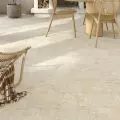The second edition of the hybrid international Urban Regeneration Congress is behind us! The joint initiative of the City of Lodz and Open Eyes Economy lasted for two intensive days in the Lodz EC1 complex, and on a virtual platform. The event was held under the slogan "Climate Regeneration of Cities", and was attended by 1,200 people from all over the world. During the speeches of 130 speakers from the world of science, politics, business, architecture and academia, they discussed, among other things, what the word regeneration means, what climate problems modern cities are facing, and what we need to do for a better future. Architecture & Business was the main media partner for the entire event.
Prof. Jerzy Hausner with the latest issue of Architektura & Biznes magazine
photo: Nikolai Zakharov © OEES
The2nd Congress on Urban Regeneration held on June 7 and 8, 2022 in Lodz, Poland, was dedicated to the policies and processes of urban regeneration seen through the prism of climate change adaptation. Its main purpose was to exchange national and international experiences of cities that have undertaken adaptation measures to the ongoing climate change from different angles - spatial, demographic, economic and environmental. Speakers and participants also tried to formulate recommendations for Polish spatial and multi-stakeholder urban policies to support local adaptation strategies.
The congress was organized by the City Hall of Lodz and Open Eyes Economy
From left: Mayor of Lodz Hanna Zdanowska and Prof. Jerzy Hausner
Photo: Nikolai Zakharov © OEES
climate-driven urban regeneration
The intensive two days centered around the topic of climatic regeneration of cities (Polish cities in particular), were divided into 9 thematic tracks. Discussions and speeches took place in four spaces of EC1 (the former power plant): Machinery Hall, Crane, Turbine and Regenerator.
The first day consisted of sessions:
- Urban Agroculture in the Face of Climate Challenges,
- Urban planning and architecture in the face of the energy transition,
- Transportation and telecommunication systems under climate change conditions
- Functional and spatial structure of the city and climate change - planning and institutional challenges,
- Formation of new competencies as a foundation for the development of the regenerative city,
- City responsible for water,
- Climate change and water management in the regenerative city,
- We have the climate for it! How can architecture prevent climate change?
- Climate-resilient and climate-friendly city.
The congress was opened by Adam Pustelnik, deputy mayor of Łódź
photo: Dobrawa Bies
opening ceremony
The openingsession in the Machinery Hall was opened by Adam Pustelnik, Deputy Mayor of Lodz, saying that Lodz is a unique place, a place that, in his opinion, has undergone a huge exercise from history and has made a great evolution. He called Lodz an interesting urban planning endeavor, a work on a living organism and a project that is ongoing and its end has not yet been defined. He also stressed that in the case of Lodz, as well as Poland, cities that are trying to catch up with lost time sometimes lose important topics such as ecology and climate change in their sprint. He pointed out that the moment of reflection is extremely important, to think about key issues, because maybe we are not doing everything right.
The Congress is a huge source of inspiration, a platform, a program for the years to come and an inspiration for concrete implementation," he concluded the statement.
Day 1 of the Climate Regeneration of Cities Congress, speech by Elisa Ferreira
Photo: Nikolai Zakharov © OEES
The next speaker was Elisa Ferreira, Commissioner for Cohesion and Reform from the European Commission, who spoke about how Europe has the opportunity to become the first climate-neutral continent, but in order to do so, we need to meet three key conditions, which are: smart investment, multi-level governance, treating cities as a complex, integrated system.
We must work together to bring about green change," she concluded the speech.
Prof. Szymon Malinowski of the University of Warsaw titled his speech "Climate crisis, planetary crisis, systemic crisis," explaining that the current coupling between the human and natural systems are not enough to keep climate change and the crisis under control. He pointed out that we have two scenarios: positive and negative, and it is up to us to decide which one will happen.
Prof. Szymon Malinowski
Photo: Nikolai Zakharov © OEES
Another speech entitled. "Challenges of the 21st century for European cities - opportunities or threats" was given by Prof. Hanna Gronkiewicz-Waltz, chairwoman of the Advisory Mission "Climate Neutral and Smart Cities" of the European Commission, mayor of the City of Warsaw from 2006 to 2018. The professor pressed for a holistic approach and attention to decentralization.
The ineugural session ended with a speech by Prof. Tadeusz Markowski
Photo: Filip Szkopinski © OEES
The session was closed by Prof. Tadeusz Markowski of the University of Lodz, Vice Chairman of the Program Council of the Congress Regeneration of Industrial Cities, speaking about the new metabolism of cities and predicting that in the future cities will be generators of green energy, and each city is expected to become a city of manufacturing. He stressed that we must seek balance in nature, and building should be based on shared value, energy incentives and economic rationality. He also noted that the most important part of a city is its urban fabric, and that agro-culture is a factor in sustainable urban development.
Panel Urban agro-culture in the face of climate challenges
from left: dr. Paulina Legutko-Kobus prof. Marek Degórski,
Sebastian Górecki, Kacper Kępiński, Dr. Joanna Rayss, Magdalena Talar-Wiśniewska
Photo: Nikolai Zakharov © OEES
urban agroculture in the face of climate challenges
Prof. Tadeusz Markowski's speech was a good introduction to the next session in the Machinery Hall on agro-culture. The panel discussion was preceded by presentations by Dr. Barbara Maćkiewicz of Adam Mickiewicz University in Poznań and Agnieszka Kalinowska-Sołtys - SARP vice president for environment and climate protection.
Urban agroculture in the face of climate challenges, this was the topic of a panel led by Dr. Paulina Legutko-Kobus of the Warsaw School of Economics. Participants in the discussion were Prof. Marek Degórski (Polish Academy of Sciences), Sebastian Górecki (CEO of Intelligent Hives), Kacper Kępiński (NIAiU), Dr. Joanna Rayss (Association of Landscape Architecture), Magdalena Talar-Wiśniewska (Urban Planning Studio).
The presenter posed such questions to the participants of the debate - What climate challenges is it possible to answer through agro-culture? What are the functions of agro-culture-related areas in the city? Who and what incentives should be implemented to facilitate the development of agroculture in the city?
Panelists: Sebastian Górecki, Kacper Kępiński, Dr. Joanna Rayss, Magdalena Talar-Wiśniewska
Photo: Nikolai Zakharov © OEES
Each participant made a brief introduction, referring to the biggest problems present in cities. Prof. Marek Degórski mentioned the negative phenomena of urban heat island and concreting of cities, and proposed green roofs and abundant vegetation as solutions. Sebastian Górecki emphasized the importance of urban agriculture and startups, and Kacper Kępinski, speaking about resilience and biodiversity, drew attention to the needs of animals in the city. He was also supported by Joanna Rayss talking about moving away from welfare and thinking about all organisms. She also stressed that we should change the thinking that only rural areas are for crops and cities are for housing. Everyone agreed that we should change the attitude towards agro-culture, educate people and make them aware that agriculture can also be present in the city.
Therole of the city is important, which should see urban agriculture as part of its responsibilities and communicate to residents that they are essential, Kacper Kepinski added.
We do a lot of things zero-sum, we have a problem with mono-functionality, the key is animation, creating a variety of organizational forms, as well as spatial forms, parmaculture. The solution is also to implement animals, such as sheep in the city [...]. I'm a fan of evolution, not revolution. It's worth modifying already existing centers," supplemented Joanna Rayss.
Agro-culture is becoming a necessity, not an extravagance, we will have to implement it, we need a framework for this, including legal. Awareness building at all levels is needed. Participatory thinking and action, and room for innovation," concluded the panel by Dr. Paulina Legutko-Kobus.
How can architecture prevent climate change?
Małgorzata Tomczak, editor-in-chief of Architecture & Business, moderated a panel discussion at Generator titled We have the climate for it! How can architecture prevent climate change? Together with invited guests - Małgorzata Hanzl , PhD (Lodz University of Technology), Bartłomiej Kisielewski (architect, partner and founder, Horizone Studio, member of the Polish Green Building Association PLGBC), Mateusz Mastalski (architect Henning Larsen Architects), Hubert Trammer (New European Bauhaus), Ph. Katarzyna Zielonko-Jung (Gdansk University of Technology) discussed how to prevent and stop climate change.
The panel We have the climate for it! How can architecture prevent climate change?
from left: Huber Trammer, Bartłomiej Kisielewski, Dr. Małgorzata Hanzl, Dr. Katarzyna Zielonko-Jung and Małgorzata Tomczak
Photo: Nikolai Zakharov © OEES
Each guest was asked to give a short presentation, started by Mateusz Mastalski talking about design in times of need for immediate action. He appealed that we have increasingly limited resources, and the construction industry is responsible for 39 percent of carbonemissions . Bartlomiej Kisielewski, using a project in Jaworzno as an example, spoke about green housing development and encouraging residents to give up their cars in favor of walking. Dr. Katarzyna Zielonko-Jung stressed that there is a need to return to an earlier model - humans as part of nature, not its center.
Circular economy - matter must not become waste, nothing should be wasted. In the case of objects this is easier to imagine, with buildings it is worse. We aim to close the circuits," she added.
Architecture can reduce climate change, it is important to, use what is there and reach for old solutions. I call it instaration, because old solutions are often better than new ones," said Hubert Trammer.
discussion in the Generator
from left: Huber Trammer, Bartłomiej Kisielewski, Dr. hab. Małgorzata Hanzl, Dr. hab. Katarzyna Zielonko-Jung and Małgorzata Tomczak
Photo: Nikolai Zakharov © OEES
Hubert also referred to the provision in the Polish Constitution on meeting housing needs, which unfortunately is not taken into account. He asked the question, do we want to draw models from Copenhagen or Moscow? Moderator Malgorzata Tomczak also touched on the New Bauhaus and its role in popularizing the principles of the European Green Deal. She then asked Matusz a question about Copenhagen and urban adaptation to climate change and what that looks like in practice.
It is reducing production, celebrating what is already there. Maybe for a while we shouldn't build and rethink how we use materials, what to do with old structures? - he answered.
A question was also raised about wood - to what extent is it a trend in zero-carbon architecture, and to what extent is it the real answer?
There is the question, if we were all to switch to wood, would there be enough forests? In Poland, we use more wood to burn than if we built everything out of it [...]. Burning wood is a rubbish that it doesn't cause a carbon footprint - in other words, greenwashing. There is also the problem of localness here, if wood is to be imported, it still produces a carbon footprint," Hubert replied.
What procedures do we have in cities that respond to climate change, and how unadaptive are these practices? - the A&B editor further asked.
Thetime horizon should be part of planning, it is impossible to act quickly when planning huge investments. An important element is to think about the culture of space use, it is important to consciously influence the behavior and activities of residents. It is best to plan short-term actions, tactics are an element of strategy," replied Dr. Małgorzata Hanzl.
Planning procedures are completely inadequate, there is a gap between the project and the documentation, these are plots, dots, data that go to the office. We can't delude ourselves that investors will of their own accord do more than the minimum [...]. We will have environmentally friendly buildings, but we won't have a concrete city if the law and policies don't change ," said Dr. Katarzyna Zielonko-Jung.
It doesn't matter what city of Poland or Europe we are in, people are needed to make good changes work, the more these topics, not only among specialists, but wider becomes on theagenda, the more it will happen and come to fruition among individuals and decision-makers who spend our collective money on public investments. Let's get this on the agenda and hope that a drop drills the rock," concluded Bartlomiej Kisielewski.
For coverage of the second day, visit the following page.





















































































